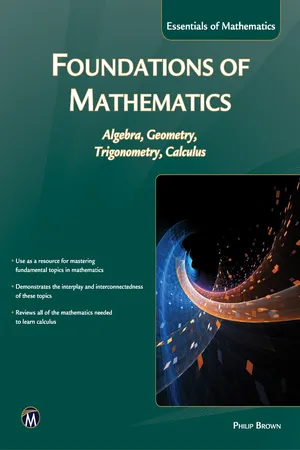Mathematics
Perpendicular Lines
Perpendicular lines are two straight lines that intersect at a 90-degree angle. In a coordinate plane, the slopes of perpendicular lines are negative reciprocals of each other. This relationship is a fundamental concept in geometry and is used in various mathematical applications, such as finding the equation of a line perpendicular to a given line.
Written by Perlego with AI-assistance
Related key terms
4 Key excerpts on "Perpendicular Lines"
- eBook - ePub
Military schools and courses of instruction in the science and art of war,
in France, Prussia, Austria, Russia, Sweden, Switzerland, Sardinia, England, and the United States. Drawn from recent official reports and documents. Revised Edition
- (Author)
- 2013(Publication Date)
- Perlego(Publisher)
From a given point to let fall a perpendicular on a plane; to find the foot and the length of that perpendicular (rectangular co-ordinates). Through a given point to pass a plane perpendicular to a given right line (rectangular co-ordinates). Through a given point, to pass a perpendicular to a given right line; to determine the foot and the length of that perpendicular (rectangular co-ordinates). Knowing the equations of a right line, to determine the angles which that line makes with the axes of the co-ordinates (rectangular co-ordinates). To find the angle of two right lines whose equations are known (rectangular co-ordinates). Knowing the equation of a plane, to find the angles which it makes with the co-ordinate planes (rectangular co-ordinates). To determine the angle of two planes (rectangular co-ordinates). To find the angle of a right line and of a plane (rectangular co-ordinates).Surfaces of the second degree.They are divided into two classes; one class having a centre, the other not having any. Co-ordinates of the centre. - eBook - ePub
- Harold E. Wolfe(Author)
- 2013(Publication Date)
- Dover Publications(Publisher)
But two lines do not need to be intersecting in order to have a common parallel. A common parallel can be constructed for any two lines. If they do not intersect, one has only to draw through any point of the first a parallel to the second and then construct a common parallel to the pair of intersecting lines. Obviously two parallel lines have only one common parallel which is parallel to them in opposite directions.Finally, interpreted otherwise, this construction of a line parallel to two lines in given senses enables us to effect the construction of the line joining any two given ideal points. 51. The Construction of a Line Perpendicular to One of Two Intersecting Lines and Parallel to the Other.We return now to the problem of constructing a line perpendicular to one of two intersecting lines and parallel to the other, or, otherwise, of constructing the distance corresponding to any acute angle regarded as an angle of parallelism. This construction is readily accomplished by the use of the results of the last section.Figure 49Given the acute angle ABC (Fig. 49 ), we wish to construct a line perpendicular to BA and parallel to BC. All that is needed is to construct the angle ABD equal to angle ABC. Then the common parallel to BC and BD will be perpendicular to BA and parallel to BC. This construction can always be made, whatever the size of the given acute angle, no matter how small or how near a right angle.Here again attention is called to the generality of the construction. A line can be constructed perpendicular to one of two lines and parallel to the other even when they do not intersect, whether they be parallel or non-intersecting. The modification of the construction for these cases has already been suggested.EXERCISEHow many lines can be constructed which are perpendicular to one of two given lines and parallel to the other, if the given lines (a) intersect at an acute angle? (b) are perpendicular? (c) are parallel? (d) are non-intersecting?52. Units of Length and Angle.We speak of the units which we use for measuring angles as being absolute - eBook - ePub
Foundations of Mathematics
Algebra, Geometry, Trigonometry and Calculus
- Philip Brown(Author)
- 2016(Publication Date)
- Mercury Learning and Information(Publisher)
quadrants (first, second, third, and fourth quadrants) that can be labeled as I, II, III, and IV, respectively, in a counterclockwise order, starting with the upper right quadrant.FIGURE 2.2. Points in the Cartesian plane.2.3LINEAR EQUATIONS AND STRAIGHT LINES
Much of mathematics involves the study of related quantities in the form of equations. For this reason, we begin with a study of linear equations and the graphs (infinite straight lines) of linear equations in the Cartesian plane because these quantify the simplest kind of relationship (linear) that related quantities can have. We will refer to an “infinite straight line” (in the Cartesian plane) as a “line.”When a line is drawn in the Cartesian plane, it can be described as a line leaning to the right if the y-coordinates of points on the line increase as the corresponding x-coordinates increase, as a line leaning to the left if the y-coordinates of points on the line decrease as the corresponding x-coordinates increase, or as a horizontal or vertical line (refer to figure 2.3 .). The point where a line crosses the x-axis (if any) is called an x-intercept, and a point where the line crosses the y-axis (if any) is called a y-intercept.There is a relationship between lines in the Cartesian plane and linear equations.DEFINITION 2.3.1. A linear equation is an equation of the form:y = mx + c,(or one of the equivalent forms stated below), where m and c are real numbers and x and y are variables. The variable - Michael R. Lindeburg(Author)
- 2017(Publication Date)
- PPI, a Kaplan Company(Publisher)
Chapter 2. Analytic Geometry and Trigonometry 1. Straight Lines 2. Polynomial Functions 3. Conic Sections 4. Quadric Surface (Sphere) 5. Distance Between Points in Space 6. Degrees and Radians 7. Plane Angles 8. Triangles 9. Right Triangles 10. Trigonometric Identities 11. General Triangles 12. Mensuration of Areas 13. Mensuration of Volumes 1. Straight Lines Figure 2.1 is a straight line in two-dimensional space. The slope of the line is m, the y -intercept is b, and the x -intercept is a. A known point on the line is represented as. Figure 2.1 Straight Line Equation 2.1 : Slope 2.1 Description Given two points on a straight line, (x 1, y 1) and (x 2, y 2), Eq. 2.1 gives the slope of the line. The slopes of two parallel lines are equal. Example Find the slope of the line that passes through points (–3, 2) and (5, –2). (A) –2 (B) –0.5 (C) 0.5 (D) 2 Solution Use Eq. 2.1. The answer is (B). Equation 2.2 : Slopes of Perpendicular Lines 2.2 Description If two lines are perpendicular to each other, then their slopes, m 1 and m 2, are negative reciprocals of each other, as shown by Eq. 2.2. For example, if the slope of a line is 5, the slope of a line perpendicular to it is –1/5. Example A line goes through the point and is perpendicular to the line y = 4 x + 10. What is the equation of the line? (A) (B) (C) (D) Solution The slopes of two lines that are perpendicular are related by The slope of the line perpendicular to the line with slope m 1 = 4 is The equation of the line is in the form., and a known point is =. The equation of the line is The answer is (B). Equation 2.3 : Standard Form of the Equation of a Line 2.3 Description The equation of a line can be represented in several forms. The procedure for finding the equation depends on the form chosen to represent the line. In general, the procedure involves substituting one or more known points on the line into the equation in order to determine the constants. Equation 2.3 is the standard form of the equation of a line
Learn about this page
Index pages curate the most relevant extracts from our library of academic textbooks. They’ve been created using an in-house natural language model (NLM), each adding context and meaning to key research topics.



